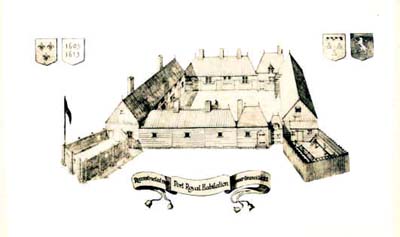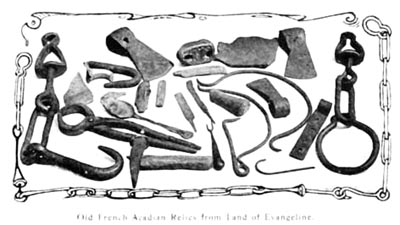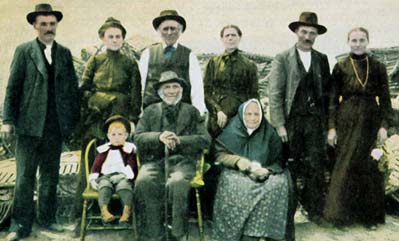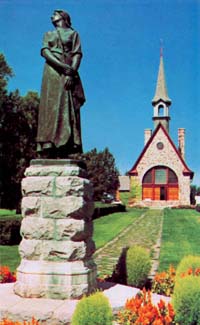Les Acadiens
Resilient Settlers of the New World
The Acadians from France are the original North American
settlers. Today they form pockets of distinct communities in Canada’s Maritime
Provinces, Québec, and Louisiana. The first true Acadian families
trace their origins to approximately 300 people who settled Port-Royal
and the fertile Annapolis Valley as early as the 1630s; small numbers subsequently
settled the Minas Basin, Cape Sable, and the Canso areas of present-day
Nova Scotia – peninsular lands formerly called Acadia.

|
| Established near the
mouth of the Annapolis River in Nova Scotia, Port-Royal Habitation was
created by Pierre Du Gua de Montsand Samuel de Champlain in the summer
of 1605. The habitation consisted of a courtyard encircled by wooden buildings
suggesting a fortification. Its garden became the first experimental seed
plot in North America. Here the Ordre de Bon Temps was organized in 1606,
the first social club in North America. It was here, as well, that the
first theatre production in Canadian history took place (1606). Port-Royal
was destroyed in 1613 by English freebooter Samuel Argall. |
Unlike the fishermen who
were often temporary or intermittent settlers in the Gulf of the St. Lawrence
the Acadians were essentially farmers. They were capable of cultivating
uplands but with their ingenuity they accepted the challenge of building
and maintaining dykes in fertile wetlands. The Acadian dykes were made
from sods of marsh grasses, were equipped with sluices and clappers to
keep out salt water, and were reinforced by logs and branches. These marshland
farms, supplemented with resources from the forest and ocean, provided
most of their subsistence needs.
At their original settlement
in Port-Royal and elsewhere, Acadians, mercilessly victimized by external
forces, had little in the way of defensive support. Port-Royal was attacked
several times in the 1600s, including 1613 by Argall, 1654 by Sedgwick,
and 1690 by New England adventurer Sir William Phips. A fort built at Port-Royal
repelled two British attacks in 1707 but, in 1710, it fell again before
Nicholson with his 36 ships and 3,500 men. The treaties of St. Germain-en-Laye
(1632), Breda (1667), and Ryswick (1697) all confirmed French control of
Acadia, but French neglect made the communities vulnerable particularly
to aggressive New Englanders. Finally, in 1713, the French ceded the ancient
boundaries of Acadia to the English in the Treaty of Utrecht. The Acadians
refused to take an oath of allegiance but maintained neutrality and were
ostensibly a peaceful, pastoral community. With the rise of the French
fortress of Louisbourg as well as the French defenses at Fort Beauséjour
and other Chignecto posts, however, the British began to be uncomfortable
with their existence. After Halifax was established in 1749, in the midst
of ongoing hostilities between French and English, the British regarded
the Acadians’ persistent refusal to take an oath as a form of treason,
despite their neutrality. Just prior to the beginning of the Seven Years
War with France in 1756, the expulsion of nearly 14,000 Acadians from Acadia
was begun at Grand Pré on September 10, 1755.

|
| Some tools and early
French artifacts archaeologically dug up at the site of Port-Royal earlier
this century. |
Expulsion occurred without
consultation with the British government or notification to colonial officials
where Les Acadiens were being sent. Approximately 2,000 Acadians fled to
Île Saint-Jean (Prince Edward Island), 1,500 to New France (Québec)
on the St. Lawrence, over 1,000 to the Baie des Chaleurs and the Gaspé
Peninsula. Temporary settlements sprouted on the Miramichi and St. John
Rivers in present-day New Brunswick and on the Magdalen Islands. Another
1,000 were deported to Massachusetts, 800 to Maryland, 600 to Connecticut,
and hundreds of others to other American colonies such as New York, Pennsylvania,
Georgia, and South Carolina. Those arriving in Virginia were dispatched
to England and another 3,500 Acadians were sent back to France, a faraway
homeland they had not seen for a century and a half. During the American
Revolution, the settlement on the islands of St. Pierre and Miquelon, made
up of many who had originally left Acadia, was dispersed again, most being
transported to France. In 1785, some 1,500 of these Acadian refugees embarked
for the territory of Louisiana which had already received about 1,500 people
from the original evacuation. Throughout the diaspora, the hardiest returned
to Nova Scotia and reconnected with scattered families who had avoided
deportation. There the returnees discovered that the most fertile areas
had been taken over by the English. By 1800, some 8,000 resilient Acadians
were eking out a living in the Maritime provinces, 8,000 were surviving
in Québec, and some 10,000 in Louisiana, the latter giving rise
to “Cajun culture.”
British institutions, New England
settlers, Loyalist refugees, English, Irish, and Scottish immigration could
not suppress or expunge the many cloistered, cohesive Acadian maritime
communities. The topography of the coastline and the nature of distinct
pockets of settlement permitted an adamantine Acadian culture to thrive
during the nineteenth century in Nova Scotia, Prince Edward Island, and
especially New Brunswick. In the twentieth century, however, the English-speaking
cultural invasion of radio, television, and other media has dealt a blow
to many steadfast Acadian communities. Nonetheless, through its folklore,
literature and music, Acadian culture and its unique voice has been sustained,
even revived. The Université de Moncton (1963) in New Brunswick
and the Université Sainte-Anne in Nova Scotia have greatly assisted
in sustaining a viable, essential, and exciting Acadian character.

|
| Five-generation portrait
of the Piorier family, Acadians from the fishing village of Tignish, P.E.I.,
circa 1900. Well-known descendants of pioneering Acadians include Maurice
and Henri Richard, Jean Beliveau, Ray Bourque, and Patrick Roy, all of
National Hockey League fame. Rock superstar, Roch Voisine, has Acadian
roots as do such literary figures as Antoine Maillet and Mavis Gallant.
[Photo, courtesy Charles J. Humber Collection] |
The Acadian community
in New Brunswick, with its majority status in eastern parts of the province
and the bilingual character of its government, has been the most successful
in staking a political, economic, and cultural presence. The first elected
Acadian premier of New Brunswick, Louis J. Robichaud who governed from
1960 to 1970, passed the Official Languages Act and did much to raise the
esteem of his people and encourage a cultural revival. Acadians, as a founding
people that is neither Aboriginal, Anglophone or Quebecois, have a distinctive
role in Canadian life.
 |
The Evangeline statue, a work completed
by Louis-Philippe and Henri Hébert, sculptors of Acadian descent,
was unveiled in 1920 near Grand Pré, Nova Scotia. Interest in the
site no doubt was inspired by William Wordsworth Longfellow whose poem
"Evangeline" did much to generate worldwide interest in the tragic story
of Acadian expulsion from Nova Scotia in 1755. The chapel in the background
was built on the site of the original Acadian church and is but a reconstruction
of an early eighteenth century French chapel. It was opened in 1923. In
1956 it was acquired by the Canadian government and turned into a National
Historic Site. [Photo, courtesy Musee acadien/Universite de Moncton] |
Communities such as
Arichat and Cheticamp on Cape Breton Island, Meteghan, Pomquet, and Beliveau
Cove on mainland Nova Scotia, Tignish, and Miscouche on Prince Edward Island,
and Moncton, Shediac, Bouctouche, Caraquet, Petit-Rocher, Bathurst, and
the Madawaska Valley among others offer an Acadian flair to the Canadian
experience. Although much of the geography of original Acadia is lost,
a spiritual Acadia is reinforced by the literature of Antonine Maillet,
the historicism of Claude Leboutillier and Alphonse Deveau, and the many
works of other writers and interpreters of the Acadian experience. In 1994
the Acadians celebrated their 390th year as a distinct North American culture,
and, in 1995, the Rt. Hon. Roméo LeBlanc was appointed Governor
General of Canada, the first Acadian to hold the position.
Historian N.E.S. Griffiths
has written, “Whatever else the deportation had brought to the Acadians
it had also instilled into them a conviction of their own capacity for
survival. It is a conviction that has not yet been proven false.”
Larry Turner



